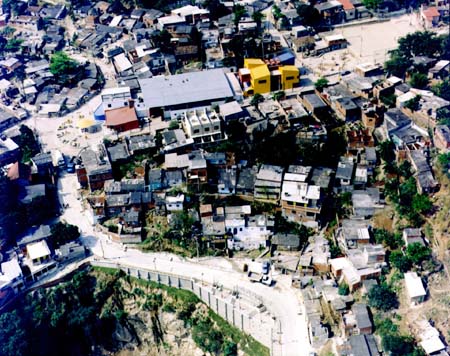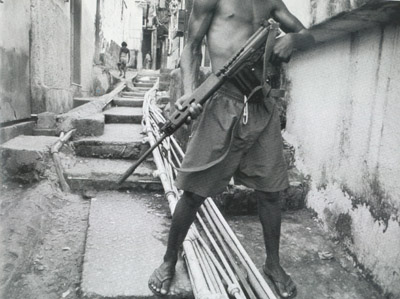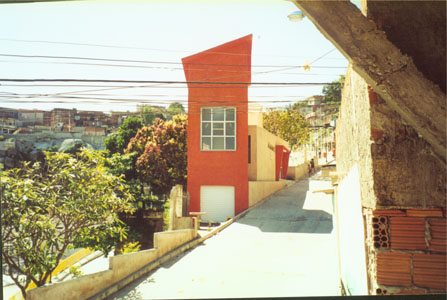| Favelas |
| Brazilian Heatwave |

Aerial view of the
core of the intervation in Campinho
Rio's
legendary favelas aren't a place you'd want to visit - let alone live
in. but Jorge Mario Jáuregui, one of the main archictects behind the award-winning
Favela-Bairro project, is transforming the landscape of Rio's most neglected
slums with an idea so basic, it's revolutionary
Rio's Favelas have been glamorized in film and in song. The infamous neighborhoods,
which first cropped up and arround the city in the 1920s, are the birthplace
of Samba and continue to play a vital role in art and national culture.
Lately, the Favelas have even become fashionable. Brazilian designers
are taking ideas, inspiration, and actual clothes and putting them in
their collections. Way on the other side of the equator, in Paris's 10th
arrondisement, there even stands a popular nightspot called Favela Chic.
But when it comes right down to it, the Favelas, translation: slums ,
are anything but chic. They are the Brazilian hotbed of poverty, crime,
and drug traffic. In a country that prides itself on Oscar Niemeyer's
precision modernism and Roberto Burle Marx's manicured gardens , these
areas were festering uncontrollably, often without electricity or running
water, and trash and raw sewage dumped into the streets. Irronically,
many of the Favelas are situated in areas of prime real estate, and until
recently, the most practical-and widely practiced-soluction was simply
to bulldoze them and kick out the residents. But for the past five years,
the Favela-Bairro project has been working to transform the slums into
functioning neighborhoods. The idea, which is a basic as it is revoluctionary,
is to provide the communities with the means, both practical and aesthetic,
where before there were none. Roads are being built, plumbing and electricity
installed, and innovative public buildings dressed in bright colors sprout
up like totems. Already a model of urban planing and design in Latin America,
Favela-Bairro received the International Architecture Biennale Grand Prize
in São Paulo in 1999, and this past year, the Veronica Rudge Green Prize
in Urban Design from the Harvard Graduate School of Design. Here, Helio
Hara talks to Jorge Mario Jáuregui, one of the main behind the project,
who is now tackling his eighteenth slum.
HELIO HARA Over a million people live in more than six-hundred slums in
Rio in extremely poor condictions. The goal of Favela-Bairro is to upgrade
all the medium- sized slums by 2004. Is there a real revolution going
on?
JORGE MARIO JÁUREGUI In 1995, Rio as a whole was really deteriorated and
the crimerate and segregation were obvious signs of the problem. In Latin
America, the response had always been the same: Bring tap water and sewage
sistems to the slums, plant a tree...Favela-Bairro was the first attempt
to come up with an integrated solution. We build schools, sports centers,
open roads making them acessible to ambulance and garbage collection,
and plant trees where possible. Slums become neighborhoods. What we realized
is that once you interfere in public areas , there's an immediate change
in the way the residents feel. Before they were ashamed to tell others
where they lived. It was a sort of lost, forgotten area. Now, there is
pride. Favela-Bairro also works on land tenure regularization and that
makes people feel more responsible. Obviously we cannot solve the problem
of drugs trafficking, which would require broader action.

HH The drug cartels
are incredibly powerful in Rio's slums: they dictate opening hours, control
the entrance to their territory...have you ever been threatened?
JMJ Drug traffickers have an ambiguous position towards favela-Bairro.
On the one hand, they know that the same roads that now allow ambulances
to reach the slum will eventually open the way for police cars. On the
other hand, they absolutely need the support from the community that want
the changes. In the future, conflict will arise, demanding a combination
of housing and security policy. In the six months we developed the project
in Fernão Cardim, for example, there was an actual war between rival groups.
Power changed hands four times . Once a severed head was left at the bar
where e used to have coffee. I remember the first time I presented the
project: It was summer. It was burnning hot. I was talking to the residents
bare -chested, covered with sweat. Suddenly, someone touched my shoulder
and introduce me to a young, well dressed guy, wearing four-hundred-dollar
Japanese trainers. I was busy, so I didn't give him much attention. Then,
I suddenly recognize that face, I had seen it in newspaper. He was the
new traffic baron there! He openly said he supported Favela-Bairro. But
that was unique.
HH The slums look random and chaotic, there's never been any sort of planning.
Now we are starting to see innovative buildings painted loud colors. Wath
is the role of aesthetics in an environment still deprived of the most
basic of needs?
JMJ Modernism decreed that it was important first to raze and than to
build up again from zero. We have a different approach; we have a lot
of respect for what is already there . We first try to understand how
the slum is organized. We can see they grow from central points like squares
and health care units. Them they try to avoid the expansion of the slum,
relocating families to the center and creating limits. In one case, we
built a sort of short "Chinese Wall" which is now used by residents as
a street. The right to beauty is as important as the right to drainage.
The loud colors are part of the popular heritage - think of Carnival.
Colors had been absent due to poverty, people work on the inside, but
cannot afford to work on the outside. And when a new, planned building
rises in the slum - be it a public toilet or a sewing co-operative - it
immediately becomes a monument. It was conceived by an architect, it indicates
things are changing: People understand they now have the right to what
was only available in the so-called "formal city"[ordinary neighborhoods].
The philosopher Felix Guattari once said that aesthetics are fundamental
and revolutionary!
HH Brazil was heavily influenced by modern architects like Le Corbusier.
There are monumental buildings in the capital, Brasilia, but poorer districts
were most often neglected.
JMJ Modern architecture really tried to make popular houses monumental
like the famous "Unité d'habitation"in Marseille, France, a project by
Le Corbusier. He tried to create a vertical, urban environment, but it
never really proved to be effective. In Brazil, there's a good example
of such monumentalism, "Pedregulho"[a sinous building in a suburb of Rio,
by architect Affonso E.Reidy]. It is really well-integrated with the environment.
But that is an isolated case. Usually, monumentalism equals high density
and low quality of life. Residents feel anonymous. We think less of vertical
towers and more of low buildings and high density.
HH You have quite controversial ideas like openning slums to tourists.
JMJ If you go to Vidigal [a slum in a hill between exclusive areas facing
the Atlantic Ocean], you have a fantastic view of the sea. It is sourronded
by five-star hotels and tourists do want to see how people live, specially
after slums are glamorized in films and songs. Such potential cannot be
ignored. In particular case of Vidigal, we have the project of a funicular
that would take people from the beach straight to the core of the slum.
Young boys would be trained as guides. Residents like to talk and are
open to people. More than once I visited a slum without giving previous
notice and I was very welcomed.
HH In the future, be it utopic or not, how do you foresee slums in Rio?
JMJ I recently visited a smaller city called Volta Redonda. There are
no slums there. What we see are popular, poorer neighborhoods. If the
country's economy improves, services and aesthetic features will also
improve in these areas. I think to give slums urban services and quality
is the most intelligent way to fight social exclusion. Before, the army
would burn shacks and raze slums. Now, it's time for a totally different
approach.

Urbanistic
and social orientation center, in the favela of Campinho
Helio
Hara
VISIONAIRE Magazine, N.Y.
Jul/Aug 2001